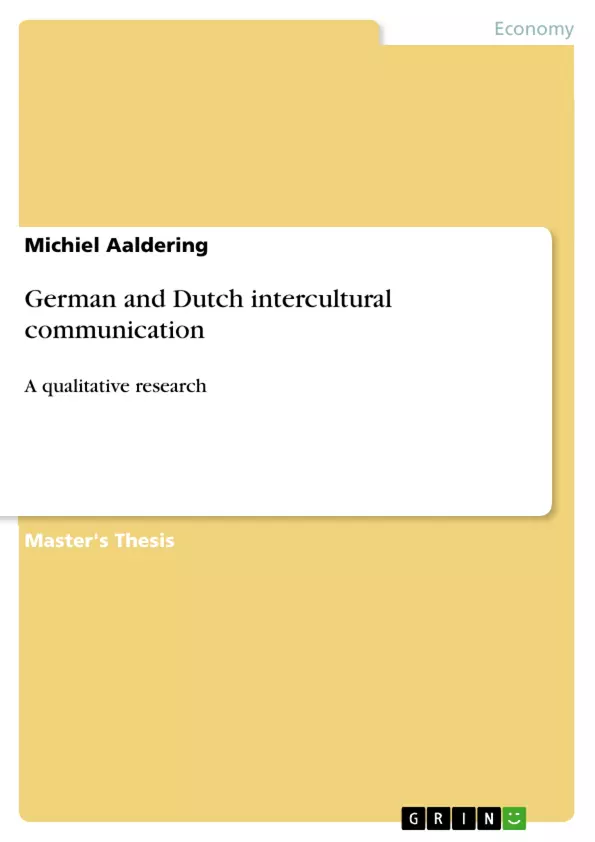
German and Dutch intercultural communication
Masterarbeit, 2008
108 Seiten, Note: 7,5 (Dutch grading scale)
Leseprobe
Table of Contents
- 1. Introduction
- 2. Literature Review
- 2.1. Culture as meaning
- 2.2. Hofstede's cultural dimensions
- 2.2.1. Germany
- 2.2.2. The Netherlands
- 2.3. The impact of culture on the organisation and on strategy
- 2.4. Historical overview
- 2.4.1. Germany
- 2.4.2. The Netherlands
- 2.5. The relationship between the two countries
- 2.5.1. Mutual cultural perceptions
- 2.5.2. Intercultural tangency
- 2.6. The languages
- 2.7. The effects of cultural meanings on work style
- 2.8. Communication style descriptor list
- 2.9. Related academic precursors
- 2.9.1. Going beyond Hofstede
- 2.9.2. Czech-German work relation
- 3. Elaboration of research questions
- 4. Methodological devices and items to take into account
- 4.1. Semi-structured interviews
- 4.2. Data sample
- 4.3. Items to take into account
- 4.3.1. Cultural values
- 4.3.2. Practices and communication styles
- 4.3.3. Additional relevant factors
- 5. Results
- 5.1. Cultural values
- 5.2. Practices and communication styles
- 6. Analyses and conclusion
- 7. Limitations and future research
Objectives and Key Themes
This master's thesis aims to investigate intercultural communication between Dutch and German individuals within small and medium-sized enterprises (SMEs). The study seeks to identify both the challenges and successes in this intercultural interaction. The research utilizes qualitative methods to understand the complexities of cross-cultural communication in a business setting.
- Cultural differences in communication styles between Dutch and German professionals.
- The impact of cultural values on business practices and strategies in Dutch-German collaborations.
- The role of language and historical context in shaping intercultural communication dynamics.
- Identification of successful strategies for overcoming intercultural communication barriers.
- Analysis of the influence of Hofstede's cultural dimensions on the observed communication patterns.
Chapter Summaries
1. Introduction: This chapter introduces the topic of intercultural communication between Dutch and German SMEs, highlighting the importance of understanding cultural differences in international business contexts. It lays the groundwork for the research by outlining the scope and objectives of the study, establishing its significance, and providing a brief overview of the methodology employed.
2. Literature Review: This chapter reviews existing literature on intercultural communication, focusing on relevant theoretical frameworks such as Hofstede's cultural dimensions. It delves into the cultural specifics of both Germany and the Netherlands, examining their historical contexts and their mutual perceptions. The chapter also explores the impact of culture on organizational structures and strategies, analyzing how cultural meanings affect work styles and communication preferences. Key communication styles are identified and contrasted, setting the stage for the empirical research. The review also examines studies that expand upon Hofstede's model and looks at prior research regarding Czech-German work relations for comparative insights.
3. Elaboration of research questions: This chapter clearly articulates the specific research questions guiding the study, providing a focused framework for the subsequent data collection and analysis. The questions likely address the core themes introduced in the literature review and are designed to offer actionable insights into the complexities of Dutch-German intercultural communication in a business context. They lay out the specific areas where the research will seek to uncover insights and provide answers.
4. Methodological devices and items to take into account: This chapter details the methodological approach employed in the research. It explains the rationale for choosing semi-structured interviews as the primary data collection method and justifies the selection of the data sample. The chapter further outlines the key factors considered during data analysis, emphasizing the importance of cultural values, communication styles, and other relevant contextual elements in understanding the complex interplay of factors affecting intercultural interactions. It clarifies the analytical lens through which the data will be interpreted and how the chosen approach mitigates potential biases.
5. Results: This chapter presents the findings of the empirical research. It systematically presents the data collected through semi-structured interviews, organized around cultural values (e.g., Masculinity vs. Femininity, Uncertainty Avoidance) and specific communication practices (formality, negotiation strategies, etc.). This section likely showcases the prevalence of particular patterns and contrasts the observed behaviors between Dutch and German participants. It lays the groundwork for the analyses provided in the following chapter.
Keywords
Intercultural communication, Dutch-German relations, SMEs, qualitative research, Hofstede's cultural dimensions, communication styles, cultural values, business practices, negotiation strategies, cross-cultural collaboration.
Frequently Asked Questions: Intercultural Communication Between Dutch and German SMEs
What is the main topic of this master's thesis?
This master's thesis investigates intercultural communication between Dutch and German individuals within small and medium-sized enterprises (SMEs). It focuses on identifying both the challenges and successes in this intercultural interaction, utilizing qualitative methods to understand the complexities of cross-cultural communication in a business setting.
What are the key themes explored in the research?
The research explores cultural differences in communication styles between Dutch and German professionals, the impact of cultural values on business practices and strategies in Dutch-German collaborations, the role of language and historical context in shaping intercultural communication dynamics, successful strategies for overcoming intercultural communication barriers, and the influence of Hofstede's cultural dimensions on observed communication patterns.
What is the structure of the thesis?
The thesis is structured as follows: an introduction, a literature review covering cultural theories (including Hofstede's dimensions), historical context, and previous research; an elaboration of the research questions; a description of the methodology (semi-structured interviews); presentation of results categorized by cultural values and communication styles; analysis and conclusion; and finally, limitations and suggestions for future research.
What methodology is used in this research?
The research employs qualitative methods, primarily semi-structured interviews, to gather data. The data sample, specific items taken into account (cultural values, communication styles, and other relevant factors), and the analysis process are detailed in the thesis.
What specific cultural aspects are considered?
The research considers Hofstede's cultural dimensions as a framework, examining specific cultural values and practices in both Dutch and German contexts. It also analyzes the impact of historical relationships and mutual cultural perceptions on communication dynamics.
What are the key findings of the study (in general terms)?
The results chapter presents findings organized around cultural values (e.g., Masculinity vs. Femininity, Uncertainty Avoidance) and communication practices (formality, negotiation strategies, etc.), contrasting observations between Dutch and German participants. Specific findings are detailed within the thesis itself.
What are the limitations of the study?
The limitations of the study are discussed in a dedicated chapter. This section likely addresses potential biases, the scope of the sample, and aspects that future research could address to expand upon the current findings.
What are the keywords associated with this research?
Key words include: Intercultural communication, Dutch-German relations, SMEs, qualitative research, Hofstede's cultural dimensions, communication styles, cultural values, business practices, negotiation strategies, and cross-cultural collaboration.
Where can I find more detailed information about the specific research questions?
The specific research questions that guided the study are clearly articulated in a dedicated chapter ("Elaboration of research questions").
What is the significance of this research?
The research aims to provide actionable insights into the complexities of Dutch-German intercultural communication in a business context, contributing to a better understanding of cross-cultural collaboration in SMEs and identifying strategies to overcome communication barriers.
Details
- Titel
- German and Dutch intercultural communication
- Untertitel
- A qualitative research
- Hochschule
- Universiteit Maastricht
- Note
- 7,5 (Dutch grading scale)
- Autor
- Michiel Aaldering (Autor:in)
- Erscheinungsjahr
- 2008
- Seiten
- 108
- Katalognummer
- V158182
- ISBN (eBook)
- 9783640710874
- ISBN (Buch)
- 9783640710973
- Dateigröße
- 1897 KB
- Sprache
- Englisch
- Schlagworte
- German Dutch
- Produktsicherheit
- GRIN Publishing GmbH
- Preis (Ebook)
- US$ 40,99
- Preis (Book)
- US$ 52,99
- Arbeit zitieren
- Michiel Aaldering (Autor:in), 2008, German and Dutch intercultural communication, München, Page::Imprint:: GRINVerlagOHG, https://www.diplomarbeiten24.de/document/158182
- Autor werden
- Ihre Optionen
- Vertriebskanäle
- Premium Services
- Autorenprofil
- Textarten und Formate
- Services für Verlage, Hochschulen, Unternehmen

- © GRIN Publishing GmbH.
- Alle Inhalte urheberrechtlich geschützt. Kopieren und verbreiten untersagt.
- info@grin.com
- AGB
- Open Publishing
Der GRIN Verlag hat sich seit 1998 auf die Veröffentlichung akademischer eBooks und Bücher spezialisiert. Der GRIN Verlag steht damit als erstes Unternehmen für User Generated Quality Content. Die Verlagsseiten GRIN.com, Hausarbeiten.de und Diplomarbeiten24 bieten für Hochschullehrer, Absolventen und Studenten die ideale Plattform, wissenschaftliche Texte wie Hausarbeiten, Referate, Bachelorarbeiten, Masterarbeiten, Diplomarbeiten, Dissertationen und wissenschaftliche Aufsätze einem breiten Publikum zu präsentieren.
Kostenfreie Veröffentlichung: Hausarbeit, Bachelorarbeit, Diplomarbeit, Dissertation, Masterarbeit, Interpretation oder Referat jetzt veröffentlichen!
- GRIN Verlag GmbH
-
- Nymphenburger Str. 86
- 80636
- Munich, Deutschland
- +49 89-550559-0
- +49 89-550559-10
- info@grin.com
-









